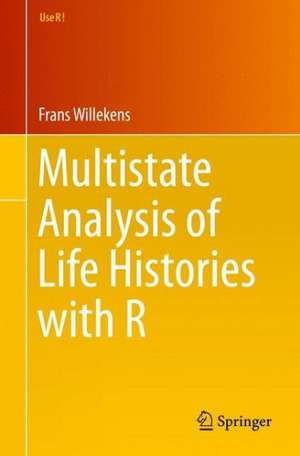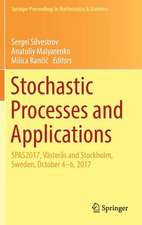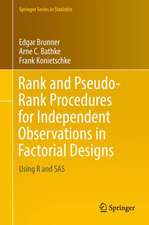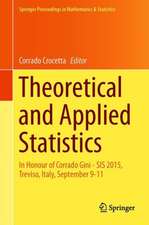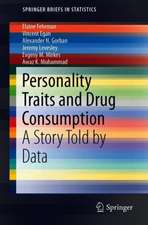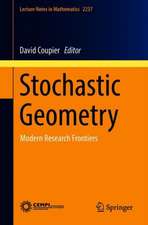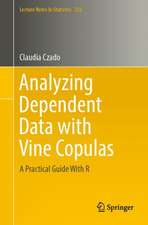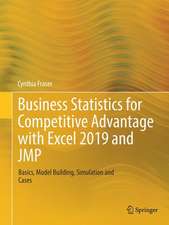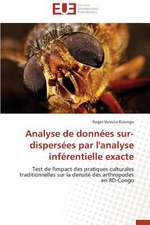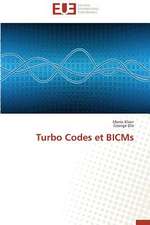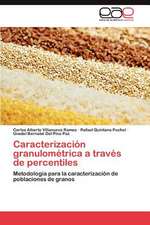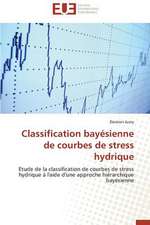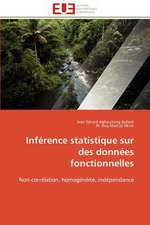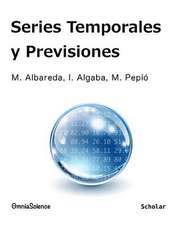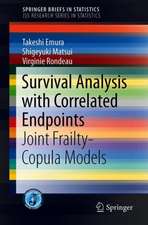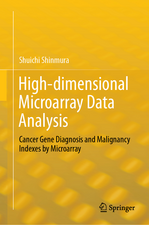Multistate Analysis of Life Histories with R: Use R!
Autor Frans Willekensen Limba Engleză Paperback – 23 sep 2014
The Comprehensive R Network Archive (CRAN) includes several packages for multistate modeling. This book is about Biograph. The package is designed to (a) enhance exploratory analysis of life histories and (b) make multistate modeling accessible. The package incorporates utilities that connect to several packages for multistate modeling, including survival, eha, Epi, mvna<, etm, mstate, msm, and TraMineR for sequence analysis. The book is a ‘hands-on’ presentation of Biograph and the packages listed. It is written from the perspective of the user. To help the user master the techniques and the software, a single data set is used to illustrate the methods and software. It is the subsample of the German Life History Survey, which was also used by Blossfeld and Rohwer in their popular textbook on event history modeling. Another
data set, the Netherlands Family and Fertility Survey, is used to illustrate how Biograph can assist in answering questions on life paths of cohorts and individuals. The book is suitable as a textbook for graduate courses on event history analysis and introductory courses on competing risks and multistate models. It may also be used as a self-study book. The R code used in the book is available online.
Frans Willekens is affiliated with the Max Planck Institute for Demographic Research (MPIDR) in Rostock, Germany. He is Emeritus Professor of Demography at the University of Groningen, a Honorary Fellow of the Netherlands Interdisciplinary Demographic Institute (NIDI) in the Hague, and a Research Associate of the International Institute for Applied Systems Analysis (IIASA), Laxenburg, Austria. He is a member of Royal Netherlands Academy of Arts and Sciences (KNAW). He has contributed to the modeling and simulation of life histories, mainly in the context of population forecasting.
Din seria Use R!
- 15%
 Preț: 676.86 lei
Preț: 676.86 lei - 17%
 Preț: 362.75 lei
Preț: 362.75 lei - 15%
 Preț: 591.79 lei
Preț: 591.79 lei - 17%
 Preț: 362.16 lei
Preț: 362.16 lei - 17%
 Preț: 461.37 lei
Preț: 461.37 lei -
 Preț: 226.74 lei
Preț: 226.74 lei - 17%
 Preț: 395.94 lei
Preț: 395.94 lei -
 Preț: 374.87 lei
Preț: 374.87 lei - 20%
 Preț: 500.66 lei
Preț: 500.66 lei - 17%
 Preț: 396.92 lei
Preț: 396.92 lei - 15%
 Preț: 360.59 lei
Preț: 360.59 lei - 17%
 Preț: 430.21 lei
Preț: 430.21 lei -
 Preț: 276.09 lei
Preț: 276.09 lei - 15%
 Preț: 497.12 lei
Preț: 497.12 lei - 15%
 Preț: 471.53 lei
Preț: 471.53 lei - 15%
 Preț: 525.35 lei
Preț: 525.35 lei -
 Preț: 489.30 lei
Preț: 489.30 lei - 15%
 Preț: 523.07 lei
Preț: 523.07 lei -
 Preț: 455.89 lei
Preț: 455.89 lei - 15%
 Preț: 518.73 lei
Preț: 518.73 lei - 18%
 Preț: 835.24 lei
Preț: 835.24 lei - 15%
 Preț: 498.94 lei
Preț: 498.94 lei - 18%
 Preț: 783.35 lei
Preț: 783.35 lei - 18%
 Preț: 783.20 lei
Preț: 783.20 lei - 15%
 Preț: 523.91 lei
Preț: 523.91 lei -
 Preț: 484.47 lei
Preț: 484.47 lei -
 Preț: 420.40 lei
Preț: 420.40 lei - 15%
 Preț: 523.07 lei
Preț: 523.07 lei -
 Preț: 419.06 lei
Preț: 419.06 lei - 15%
 Preț: 695.70 lei
Preț: 695.70 lei - 15%
 Preț: 499.12 lei
Preț: 499.12 lei - 15%
 Preț: 493.89 lei
Preț: 493.89 lei - 15%
 Preț: 584.10 lei
Preț: 584.10 lei - 15%
 Preț: 591.47 lei
Preț: 591.47 lei - 15%
 Preț: 497.31 lei
Preț: 497.31 lei - 15%
 Preț: 696.02 lei
Preț: 696.02 lei -
 Preț: 420.02 lei
Preț: 420.02 lei -
 Preț: 489.87 lei
Preț: 489.87 lei - 15%
 Preț: 579.66 lei
Preț: 579.66 lei -
 Preț: 486.42 lei
Preț: 486.42 lei - 15%
 Preț: 507.95 lei
Preț: 507.95 lei -
 Preț: 388.34 lei
Preț: 388.34 lei - 15%
 Preț: 496.67 lei
Preț: 496.67 lei - 15%
 Preț: 520.61 lei
Preț: 520.61 lei - 15%
 Preț: 531.26 lei
Preț: 531.26 lei - 15%
 Preț: 576.52 lei
Preț: 576.52 lei -
 Preț: 454.16 lei
Preț: 454.16 lei
Preț: 423.47 lei
Nou
Puncte Express: 635
Preț estimativ în valută:
81.04€ • 87.100$ • 68.07£
81.04€ • 87.100$ • 68.07£
Carte tipărită la comandă
Livrare economică 22 aprilie-06 mai
Preluare comenzi: 021 569.72.76
Specificații
ISBN-13: 9783319083827
ISBN-10: 3319083821
Pagini: 290
Ilustrații: XXII, 308 p. 45 illus., 36 illus. in color.
Dimensiuni: 155 x 235 x 20 mm
Greutate: 0.47 kg
Ediția:2014
Editura: Springer International Publishing
Colecția Springer
Seria Use R!
Locul publicării:Cham, Switzerland
ISBN-10: 3319083821
Pagini: 290
Ilustrații: XXII, 308 p. 45 illus., 36 illus. in color.
Dimensiuni: 155 x 235 x 20 mm
Greutate: 0.47 kg
Ediția:2014
Editura: Springer International Publishing
Colecția Springer
Seria Use R!
Locul publicării:Cham, Switzerland
Public țintă
ResearchCuprins
Introduction.- Life Histories: Real and Synthetic.- The Biograph Object.- Exploratory Data Analysis.- Visualization of Event Histories and State Sequences.- Statistical Packages for Multistate Event History Analysis.- The Multistate Life Table.- Application to Netherlands Family and Fertility Survey.- Summary.- Annexes.
Recenzii
“The book is largely built around a description of population change as a set of life histories, viewed as the realization of stochastic processes. … This book is a very nice addition to the many other important methodological contributions made by Frans Willekens and I recommend that it be read by all demographers … .” (David A. Swanson, Canadian Studies in Population, Vol. 42 (3-4), 2015)
“This book is about pragmatic analysisof life histories using a selection of packages for statistical programminglanguage R. … I recommend the book for everyone interested in pragmaticanalyses of life histories with R. … successfully provides a well-justifiedselection of useful methods with (now) well-documented tools for pragmatic analysesof multistate life histories.” (Reijo Sund, International Statistical Review, Vol.83 (2), 2015)
“This book is about pragmatic analysisof life histories using a selection of packages for statistical programminglanguage R. … I recommend the book for everyone interested in pragmaticanalyses of life histories with R. … successfully provides a well-justifiedselection of useful methods with (now) well-documented tools for pragmatic analysesof multistate life histories.” (Reijo Sund, International Statistical Review, Vol.83 (2), 2015)
Notă biografică
Frans Willekens is affiliated with the Max Planck Institute for Demographic Research (MPIDR) in Rostock, Germany. He is Emeritus Professor of Demography at the University of Groningen, a Honorary Fellow of the Netherlands Interdisciplinary Demographic Institute (NIDI) in the Hague, and a Research Associate of the International Institute for Applied Systems Analysis (IIASA), Laxenburg, Austria. He is a member of Royal Netherlands Academy of Arts and Sciences (KNAW). He has contributed to the modeling and simulation of life histories, mainly in the context of population forecasting.
Textul de pe ultima copertă
This book provides an introduction to multistate event history analysis. It is an extension of survival analysis, in which a single terminal event (endpoint) is considered and the time-to-event is studied. Multistate models focus on life histories or trajectories, conceptualized as sequences of states and sequences of transitions between states. Life histories are modeled as realizations of continuous-time Markov processes. The model parameters, transition rates, are estimated from data on event counts and populations at risk, using the statistical theory of counting processes.
The Comprehensive R Network Archive (CRAN) includes several packages for multistate modeling. This book is about Biograph. The package is designed to (a) enhance exploratory analysis of life histories and (b) make multistate modeling accessible. The package incorporates utilities that connect to several packages for multistate modeling, including survival, eha, Epi, mvna<, etm, mstate, msm, and TraMineR for sequence analysis. The book is a ‘hands-on’ presentation of Biograph and the packages listed. It is written from the perspective of the user. To help the user master the techniques and the software, a single data set is used to illustrate the methods and software. It is the subsample of the German Life History Survey, which was also used by Blossfeld and Rohwer in their popular textbook on event history modeling. Another
data set, the Netherlands Family and Fertility Survey, is used to illustrate how Biograph can assist in answering questions on life paths of cohorts and individuals. The book is suitable as a textbook for graduate courses on event history analysis and introductory courses on competing risks and multistate models. It may also be used as a self-study book. The R code used in the book is available online.
Frans Willekens is affiliated with the Max Planck Institute for Demographic Research (MPIDR) in Rostock, Germany. He is Emeritus Professor of Demography at the University of Groningen, a Honorary Fellow of the Netherlands Interdisciplinary Demographic Institute (NIDI) in the Hague, and a Research Associate of the International Institute for Applied Systems Analysis (IIASA), Laxenburg, Austria. He has contributed to the modeling and simulation of life histories, mainly in the context of population forecasting.
The Comprehensive R Network Archive (CRAN) includes several packages for multistate modeling. This book is about Biograph. The package is designed to (a) enhance exploratory analysis of life histories and (b) make multistate modeling accessible. The package incorporates utilities that connect to several packages for multistate modeling, including survival, eha, Epi, mvna<, etm, mstate, msm, and TraMineR for sequence analysis. The book is a ‘hands-on’ presentation of Biograph and the packages listed. It is written from the perspective of the user. To help the user master the techniques and the software, a single data set is used to illustrate the methods and software. It is the subsample of the German Life History Survey, which was also used by Blossfeld and Rohwer in their popular textbook on event history modeling. Another
data set, the Netherlands Family and Fertility Survey, is used to illustrate how Biograph can assist in answering questions on life paths of cohorts and individuals. The book is suitable as a textbook for graduate courses on event history analysis and introductory courses on competing risks and multistate models. It may also be used as a self-study book. The R code used in the book is available online.
Frans Willekens is affiliated with the Max Planck Institute for Demographic Research (MPIDR) in Rostock, Germany. He is Emeritus Professor of Demography at the University of Groningen, a Honorary Fellow of the Netherlands Interdisciplinary Demographic Institute (NIDI) in the Hague, and a Research Associate of the International Institute for Applied Systems Analysis (IIASA), Laxenburg, Austria. He has contributed to the modeling and simulation of life histories, mainly in the context of population forecasting.
Caracteristici
Presents a step-by-step procedure for investigating life histories using descriptive methods and statistical modeling, as well as the popular software language for statistical computing (R) For educational purposes, a single data set is used throughout the book: a subsample of the German Life History Survey (201 respondents) In the last chapter, a second data set is used: a subsample of the Netherlands Family and Fertility Survey (500 respondents) The appendix details how to start applying Biograph to other major data sets, including the Survey of Health, Ageing and Retirement in Europe (SHARE) and the Demographic and Health Survey Life history data is visualized using ggplot2 Includes supplementary material: sn.pub/extras
